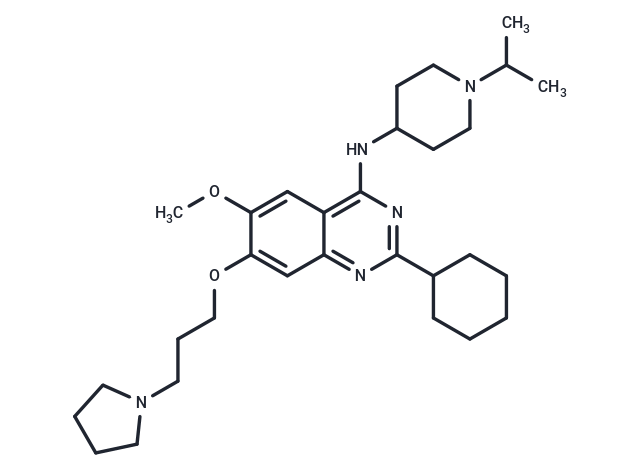Shopping Cart
- Remove All
 Your shopping cart is currently empty
Your shopping cart is currently empty

UNC0638 is an inhibitor of β-protein lysine methyltransferases G9a(IC50<15 nM) and GLP(IC50=19 nM) with excellent potency and selectivity over a wide range of epigenetic and non-epigenetic targets.

| Pack Size | Price | Availability | Quantity |
|---|---|---|---|
| 5 mg | $54 | In Stock | |
| 10 mg | $81 | In Stock | |
| 25 mg | $148 | In Stock | |
| 50 mg | $270 | In Stock | |
| 100 mg | $411 | In Stock | |
| 1 mL x 10 mM (in DMSO) | $59 | In Stock |
| Description | UNC0638 is an inhibitor of β-protein lysine methyltransferases G9a(IC50<15 nM) and GLP(IC50=19 nM) with excellent potency and selectivity over a wide range of epigenetic and non-epigenetic targets. |
| Targets&IC50 | GLP:19 nM, G9a:<15 nM |
| In vitro | UNC0638 is a potent, selective and cell-penetrant chemical probe for G9a and GLP, with a toxicity/function ratio of >100, compared to <6 for BIX01294. UNC0638 is a selectivite inhibitor of G9a and GLP over a wide range of epigenetic and non-epigenetic targets. UNC0638 is more than 10,000-fold selective against SET7/9 (a H3K4 HMTase), SET8 (a H4K20 HMTase), PRMT3, and SUV39H2. In MDA-MB-231 cells, UNC0638 (48 h exposure) reduces H3K9me2 levels in a concentration-dependent manner with an IC50 of 81 nM. UNC0638 treatment of a variety of cell lines results in lower global H3K9me2 levels, equivalent to levels observed for small hairpin RNA knockdown of G9a and GLP with the functional potency of UNC0638 being well separated from its toxicity. UNC0638 markedly reduces the clonogenicity of MCF7 cells, reduces the abundance of H3K9me2 marks at promoters of known G9a-regulated endogenous genes and disproportionately affected several genomic loci encoding microRNAs. In mouse embryonic stem cells, UNC0638 reactivates G9a-silenced genes and a retroviral reporter gene in a concentration-dependent manner without promoting differentiation. [1] |
| Kinase Assay | The enzymatic reactions are conducted in duplicate at room temperature for 1 hour in a 50 μL mixture containing PKMT assay buffer, substrate coated plate, 10 M SAM, a HMT enzyme (EZH2 (800 ng/reaction), MLL (300 ng/reaction), PRMT1 (0.5 ng/reaction), SUV39H1 (75 ng/reaction) and UNC0638 (0-1.25 μM). After enzymatic reactions, 100 μL of first antibody is added to each well and the plate is incubated at room temperature for an additional 1 h. 100 μL of secondary antibody is added to each well and the plate is incubated at room temperature for an additional 30 min. 100 μL of developer reagents are added to wells and luminescence is measured using a BioTek SynergyTM 2 microplate reader. Enzyme activity assays are performed in duplicates at each concentration. The luminescence data are analyzed using the computer software, Graphpad Prism[1]. |
| Cell Research | UNC0638 is dissolved in deuterated DMSO (10 mM) and deuterated Water (90:10 ratio)[1]. MDA-MB-231, PC3, HCT116 cells are cultured in RPMI with 10% FBS, 22RV1 cells in alphaMEM and 10% FBS, MCF7 and IMR90 cells in DMEM with 10% FBS. Cells are grown in the presence or absence of UNC0638 (10 nM, 100 nM, 1 μM, 10 μM, and 100 μM ) for stated amount of time. The media is removed and replaced with DMEM 10% FBS without phenol red supplemented with 1 mg/mL of MTT and incubated for 1-2 h. Live cells reduce yellow MTT to purple formazan. The resulting formazan is solubilized in acidified isopropanol and 1% Triton and absorbance measured at 570 nm, corrected for 650 nm background[1]. |
| Molecular Weight | 509.73 |
| Formula | C30H47N5O2 |
| Cas No. | 1255580-76-7 |
| Smiles | COc1cc2c(NC3CCN(CC3)C(C)C)nc(nc2cc1OCCCN1CCCC1)C1CCCCC1 |
| Relative Density. | 1.124 g/cm3 (Predicted) |
| Storage | store at low temperature | Powder: -20°C for 3 years | In solvent: -80°C for 1 year | Shipping with blue ice. | ||||||||||||||||||||||||||||||||||||||||
| Solubility Information | DMSO: 93 mg/mL (182.45 mM), Sonication is recommended. Ethanol: 93 mg/mL (182.45 mM), Sonication is recommended. H2O: 6 mg/mL (11.77 mM), Sonication is recommended. | ||||||||||||||||||||||||||||||||||||||||
Solution Preparation Table | |||||||||||||||||||||||||||||||||||||||||
H2O/DMSO/Ethanol
DMSO/Ethanol
| |||||||||||||||||||||||||||||||||||||||||

Copyright © 2015-2025 TargetMol Chemicals Inc. All Rights Reserved.